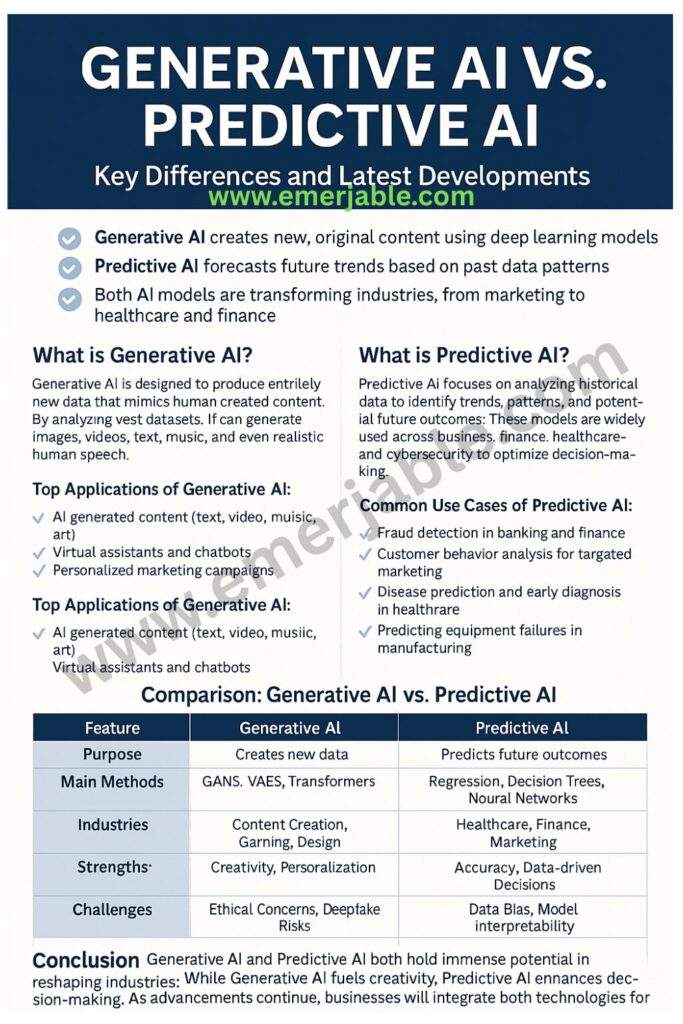Artificial Intelligence (AI) has rapidly evolved, leading to the rise of specialized branches with unique applications. Two of the most prominent AI types, Generative AI and Predictive AI, serve distinct purposes and continue to shape industries worldwide.
Key Takeaways
- Generative AI creates new, original content using deep learning models.
- Predictive AI forecasts future trends based on past data patterns.
- Both AI models are transforming industries, from marketing to healthcare and finance.
What is Generative AI?
Generative AI is designed to produce entirely new data that mimics human-created content. By analyzing vast datasets, it can generate images, videos, text, music, and even realistic human speech.
Common Generative AI Models:
- GANs (Generative Adversarial Networks): Used for hyper-realistic image generation.
- VAEs (Variational Autoencoders): Focused on learning latent space representations.
- Transformers (like GPT-4 & DALL·E): Powering AI-driven text and image creation.
Top Applications of Generative AI:
✔ AI-generated content (text, video, music, art).
✔ Virtual assistants and chatbots.
✔ Personalized marketing campaigns.
✔ AI-driven game and movie development.
What is Predictive AI?
Predictive AI focuses on analyzing historical data to identify trends, patterns, and potential future outcomes. These models are widely used across business, finance, healthcare, and cybersecurity to optimize decision-making.
Key Predictive AI Techniques:
- Regression Analysis: Helps predict numerical values (e.g., stock prices).
- Decision Trees & Random Forests: Used for classification and risk analysis.
- Neural Networks & Deep Learning: Improve forecasting accuracy over time.
Common Use Cases of Predictive AI:
✔ Fraud detection in banking and finance.
✔ Customer behavior analysis for targeted marketing.
✔ Disease prediction and early diagnosis in healthcare.
✔ Predicting equipment failures in manufacturing.
Comparison: Generative AI vs. Predictive AI
| Feature | Generative AI | Predictive AI |
|---|---|---|
| Purpose | Creates new data | Predicts future outcomes |
| Main Methods | GANs, VAEs, Transformers | Regression, Decision Trees, Neural Networks |
| Industries | Content Creation, Gaming, Design | Healthcare, Finance, Marketing |
| Strengths | Creativity, Personalization | Accuracy, Data-driven Decisions |
| Challenges | Ethical Concerns, Deepfake Risks | Data Bias, Model Interpretability |
The Future of AI: What’s Next?
AI is evolving rapidly, with both Generative and Predictive AI pushing new frontiers. Key trends include:
🚀 Multimodal AI that combines text, images, and videos for richer outputs.
🚀 AI-driven automation across industries, reducing manual effort.
🚀 More ethical AI frameworks to prevent misinformation and bias.

Conclusion
Generative AI and Predictive AI both hold immense potential in reshaping industries. While Generative AI fuels creativity, Predictive AI enhances decision-making. As advancements continue, businesses will integrate both technologies for smarter automation, deeper insights, and more personalized experiences.
For all AI News & Latest Updates, Keep Visiting Emerjable.com



